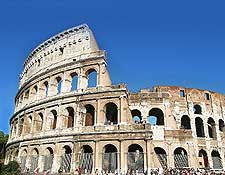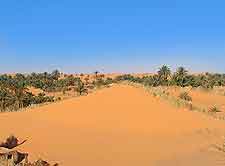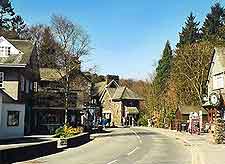World Guides Travel Blog
March 2015
This is where we let you know all about what's going on with our website and the world of travel, with destination reviews, current travel news and topical travel-related stuff to discuss with your friends. Please let us know if you want to comment on anything -
Contact us.
March 20, 2015
FAROE ISLANDS
From where I was stood, this morning's partial solar eclipse was a little disappointing. A sort of twilight descended, but cloud cover concealed anything but a quick glimpse of this astronomical event. For a moment, I wished I was in the Faroe Islands where, according to the media, thousands of spectators were plunged into darkness in spectacular fashion for a full two minutes.The Faroe Islands were, in fact, one of only two places on Earth from which you could witness the total eclipse - where the sun ws entirely covered by the moon.
The Faroe Islands have long been the haunt of astronomers who've visited this remote autonomous territory of Denmark in search of pollution-free skies and wide open vistas from which to admire the heavens. In recent years, though, the Islands' authorities are hoping to win the hearts and minds of a much wider group of tourists. The eclipse can only serve to help them with their ambitions.
In the Faroe Islands, sheep tend to outnumber people and even when you add up the land area of all 18 islands, it is still smaller than that of London. Of course, that is not a problem if you are into myths and legends, and hiking and hills. Combine the two and you could take a trip to see Risin and Kellingin, better known as 'The Giant' and the 'The Witch', two gigantic sea stacks north of Eysturoy island. For a spot of urban life, most tourists gravitate around the Faroese town of Tórshavn on the island of Streymoy. Known as one of the smallest capital cities in the world, it also has a reputation for being one of the most colourful, thanks to its brightly painted houses and grass-turfed roofs.
With rain reputed to fall on the Faroe Islands for 300 days out of every 365, it is never going to be a place that attracts the sun-seeking hordes. Unless, that is, there is another solar eclipse anytime soon.
Posted by Sue at 16:38:45 on 20/3/2015
March 13, 2015
WHEN IN ROME...

Rome is one of Europe's most beautiful cities. For that reason, it attracts thousands of visitors every day, all intent on seeing such iconic monuments as the Colosseum and the Pantheon. Yet, in recent years, tourist reports haven't all been complimentary. Some have accused the city of being ramshackle and run down. The arrival then, of a massive clean-up operation, has naturally caused quite a stir, both in and out of the city. Especially bearing in mind that the man responsible for all that shaking and stirring is none other than the fictional spy, Bond. James Bond.
By all accounts, those responsible for filming the latest in the James Bond saga, 'Spectre', have been working hard with the Roman authorities to bring about the clean up, handing out much needed cash as an incentive to rid the city of its infamous graffiti-scrawled walls and litter-strewn streets.
In the film, Bond's super stylish Aston Martin will be seen speeding through Rome in what are now obligatory car chases, handbrake turning in the narrowest of the city's streets. There is no doubting the city's heritage. When the film releases in October this year, it is worth keeping a look out for some of the city's most famous landmarks, including the Ponte Sisto, as well as classic examples of Roman architecture, from Baroque buildings to ornate squares and classical ruins.
If you fancy following in Daniel Craig's well-appointed footsteps, it is worth heading there now, before the summer crowds arrive. If not, it is perhaps best to leave it till the autumn, when they have all packed their bags and gone home.
Posted by Sue at 14:53:55 on 13/3/2015
March 5, 2015
TECHNOLOGY-FREE TRAVELLING

The other day, I came across a whole load of diaries and photographs. Scanning the grainy pictures and dog-eared notebooks from former epic trips in Europe, America and Africa, it made me realise how much the nature of travelling has changed in recent years. Back then, in the 1980s and 1990s, I set off armed only with a rucksack-load of guidebooks, my address book (for sending postcards, of course) and a wad of travellers' cheques. I was a technology-free traveller. And because of that, my journeys were undoubtedly very different from those experienced today.
On a memorable trip through Africa with my partner, communication with family and loved ones was reduced to the odd postcard, which inevitably took an age to make the arduous journey back to the UK. Even more rare were opportunities to phone home. We queued for hours to make one quick phone call from a post office in In Salah, an oasis town in central Algeria.
Likewise, the guidebooks we carried were great, but inevitably they weren't always up to date. Hotels and camp sites were no longer where they should have been. New cafes and restaurants had sprung up, whilst others had gone to the wall. Hungry and tired, we usually had to rely on legwork to find a meal and a bed for the night. I lost count of the times in the Sahara when the road disappeared completely and we had to get to grips with map and compass reading in the dark.
When it comes to travelling, it is easy to be bit by the nostalgia bug. Surely, I hear myself argue, despite all these difficulties, the pre-Internet traveller was able to experience things far more authentically? Getting lost, being faced with surprises, being far from home in all senses was part of the experience?
Actually, now I'm not so sure. Given the choice, I think I would have preferred to save my loved ones from having to wait for days and months to find out whether or not I was okay. On my African adventure, a Skype call over WiFi would have stopped my parents from going quite so grey. And whilst I agree that surprises are good, it would have saved on stress to have been able to check that the next fuel station was only just a few miles away. Lost in the Sahara (yes, there was one particularly tricky moment), it would have been handy to turn to GPS navigation for a spot of reassurance. So, whilst it is true that travelling in these digital days is a far cry from what it used to be, it is not all bad.
Posted by Sue at 14:41:20 on 5/3/2015
March 1, 2015
DANCING WITH DAFFODILS

When the poet Wordsworth wrote those famous lines, 'I wandered lonely as a cloud' over 200 years ago, I doubt he ever considered the long-lasting effect they would have. Personally, the moment I spot those familiar yellow-trumpeted flowers at the side of the road, or in front gardens, I envisage them through the eyes of Wordsworth, as 'a host, of golden daffodils'. They celebrate the arrival of spring and 'my heart with pleasure fills'.
Over the coming weeks, the bouquets of daffodils that inspired Wordsworth will be much in evidence in the poet's local landscape of the Lake District. Competition for being the most daffodil-festooned village in the area is fierce. Apparently, according to those good folk at the Lake District National Park, you are most likely to see them at their best between Patterdale and Gowbarrow by Ullswater.
If all those daffodils inspire you to find out more about Wordsworth, later on this month Dove Cottage in Grasmere, where the poet lived from 1799, will be hosting a hands-on activity for children aimed at bringing to life the places visited by Wordsworth and his fellow poets. The house will, incidentally, also be home to an exhibition on how war (the Battle of Waterloo marks its bicentenary this year) was thought to have influenced the poet's ideas and work. Also worth a visit is Rydal Mount, where Wordsworth lived from 1813 and wrote many of his poems. If you are still in search of daffodils, head down to nearby Dora's Field. By all accounts, when Wordsworth's daughter died in 1847, he's said to have planted hundreds of daffodils in a nearby field in tribute.
Posted by Sue at 14:30:55 on 1/3/2015
 Rome is one of Europe's most beautiful cities. For that reason, it attracts thousands of visitors every day, all intent on seeing such iconic monuments as the Colosseum and the Pantheon. Yet, in recent years, tourist reports haven't all been complimentary. Some have accused the city of being ramshackle and run down. The arrival then, of a massive clean-up operation, has naturally caused quite a stir, both in and out of the city. Especially bearing in mind that the man responsible for all that shaking and stirring is none other than the fictional spy, Bond. James Bond.
Rome is one of Europe's most beautiful cities. For that reason, it attracts thousands of visitors every day, all intent on seeing such iconic monuments as the Colosseum and the Pantheon. Yet, in recent years, tourist reports haven't all been complimentary. Some have accused the city of being ramshackle and run down. The arrival then, of a massive clean-up operation, has naturally caused quite a stir, both in and out of the city. Especially bearing in mind that the man responsible for all that shaking and stirring is none other than the fictional spy, Bond. James Bond. The other day, I came across a whole load of diaries and photographs. Scanning the grainy pictures and dog-eared notebooks from former epic trips in Europe, America and Africa, it made me realise how much the nature of travelling has changed in recent years. Back then, in the 1980s and 1990s, I set off armed only with a rucksack-load of guidebooks, my address book (for sending postcards, of course) and a wad of travellers' cheques. I was a technology-free traveller. And because of that, my journeys were undoubtedly very different from those experienced today.
The other day, I came across a whole load of diaries and photographs. Scanning the grainy pictures and dog-eared notebooks from former epic trips in Europe, America and Africa, it made me realise how much the nature of travelling has changed in recent years. Back then, in the 1980s and 1990s, I set off armed only with a rucksack-load of guidebooks, my address book (for sending postcards, of course) and a wad of travellers' cheques. I was a technology-free traveller. And because of that, my journeys were undoubtedly very different from those experienced today. When the poet Wordsworth wrote those famous lines, 'I wandered lonely as a cloud' over 200 years ago, I doubt he ever considered the long-lasting effect they would have. Personally, the moment I spot those familiar yellow-trumpeted flowers at the side of the road, or in front gardens, I envisage them through the eyes of Wordsworth, as 'a host, of golden daffodils'. They celebrate the arrival of spring and 'my heart with pleasure fills'.
When the poet Wordsworth wrote those famous lines, 'I wandered lonely as a cloud' over 200 years ago, I doubt he ever considered the long-lasting effect they would have. Personally, the moment I spot those familiar yellow-trumpeted flowers at the side of the road, or in front gardens, I envisage them through the eyes of Wordsworth, as 'a host, of golden daffodils'. They celebrate the arrival of spring and 'my heart with pleasure fills'.